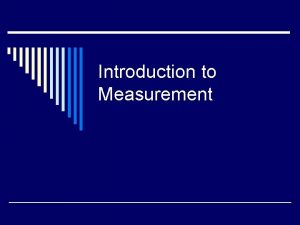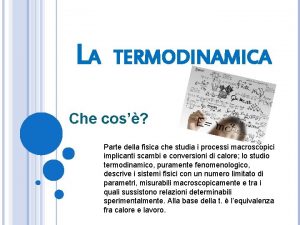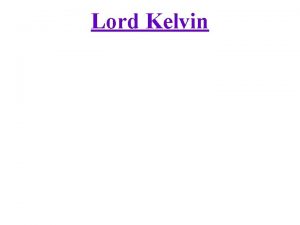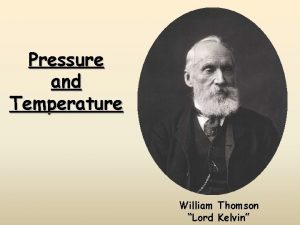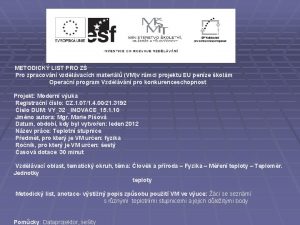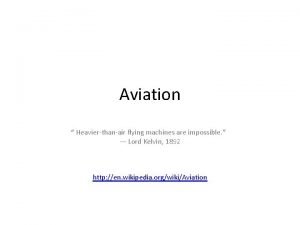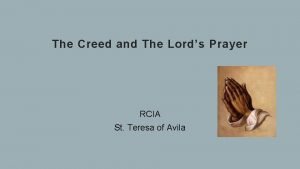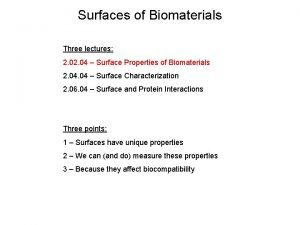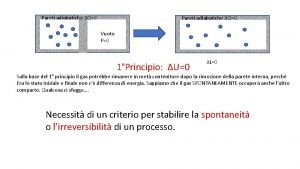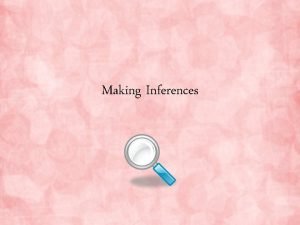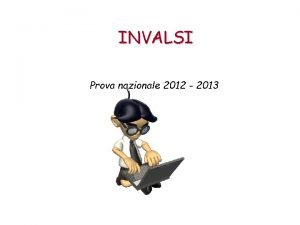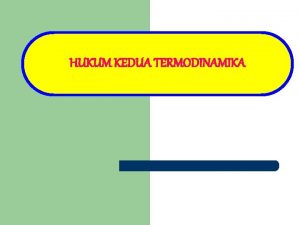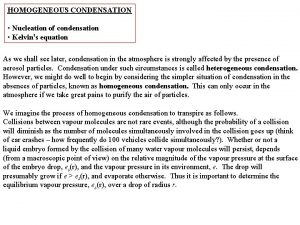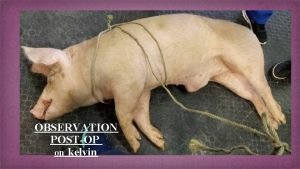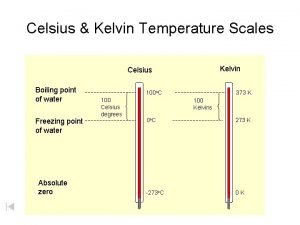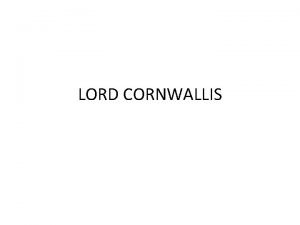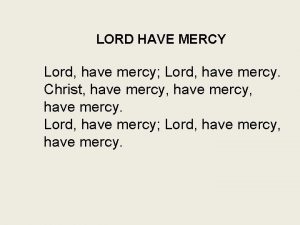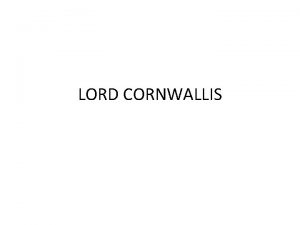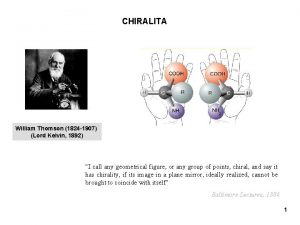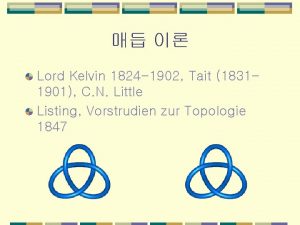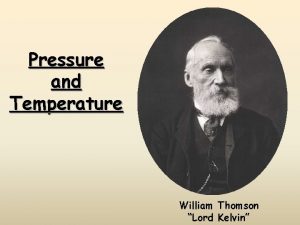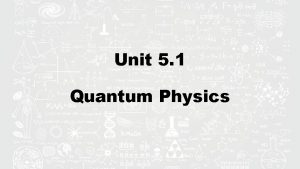PRESENTATION 1 Lord Kelvin on Measurement 2 Tom























- Slides: 23


PRESENTATION 1) Lord Kelvin on Measurement 2) Tom De. Marco on Measurement 3) Test Metric Categories 4) Testability at the Unit Test Level 5) Testability at the Integration Test Level 6) Testability at the System Test Level 7) Measuring the Complexity of Test Cases 8) Measuring the Quality of Test Cases 9) Test Case Analysis Report for FIVS 10) FIVS Test Case Quantity 11) FIVS Test Case Complexity & Quality 12) Calculating Test Costs 13) Estimating the Number of Test Cases 14) Calculating Test Effort with COCOMO-II 15) Metrics for Measuring Test Coverage 16) Metrics for Evaluating Test Effectiveness 17) Ratio of Tester to User Error Reports 18) Test Metrics from the GEOS Project 19) Defect Analysis in the GEOS Project 20) Test Metric Conclusion 21) More Research on Test Metrics required

Lord Kelvin on Measurement „When you can measure what you are speaking about, and express it in numbers, you know something about it, but when you cannot measure it, when you can not express it in numbers, then your knowledge is of a meagure and unsatisfactory kind. “ from Lord Kelvin British physicist, 1882

Tom De. Marco on Measurement „You can not control what you can not measure. Mesurement is the prerequisite to management control. “ from Tom De. Marco American Consultant, 1982

Test Metric Categories · Metrics for assessing the testability of the software · Metrics for evaluating test cases · Metrics for calculating test costs · Metrics for measuring test coverage · Metrics for assessing test effectiveness

Testability at the Unit Test Level • Unit Complexity = Size * Cohesion * Coupling • Control path complexity = Control flow branches / Statements • Interface complexity = Interfaces + Parameters / Statements • Data complexity = Conditional variables / Variables used • Unit Testability = 1 - Average (Unit-Complexity, Control-Flow-Complexity, Interface-Complexity, Data-Complexity)

Testability at the Integration Test Level • Interface volume = Interfaces / Interfaces + Components • Interface complexity = Parameters / Parameters + Interfaces • Database access frequency = Components without Database accesses / Components • Interface Visibility = invisible Interfaces / Interfaces • Integration Testability = 1 - Average (Interface-Volume, Interface-Complexity, Database. Access Frequency, Interface-Visibility)

Testability at the System Test Level • User Interface Volume = User Interfaces + Controls / System Variables • System Interface Volume = System Interfaces + Data Elements / System Variables • Database Volume = Tables + Attributes / System Variables • Use. Case Volume = Use. Cases / System Functions • System Testability = 1 - Average (User-Interface-Volume, System-Interface-Volume, Database-Volume, Use. Case-Volume)

Measuring the Complexity of Test Cases • Test data complexity = test data types / test data instances • Test data density = test control variables / test data • Test case volume = 1 – (test cases / test data instances) • Test case intensity = 1 – (use cases / test cases) • Test case complexity = Average (Test data complexity, Test data density, Test case volume, Test case intensity)

Measuring the Quality of Test Cases • Test case impact = 1 – ( test cases / impacted functions ) • Test case reusability = ( automated test cases / test cases ) • Test case conformity = ( formally correct test case attributes / total test case attributes ) • Test case affectivity = ( weighted errors detected / test cases executed ) • Test case quality = Average (Test case impact, test case reusability, test case conformity, test case affectivity)

Test Case Analysis Report for FIVS +---------------------------+ | Module: GWMBRACO Number of Test Cases = 106 | | Module: GWMDERIV Number of Test Cases = 761 | | Module: GWMEMIBE Number of Test Cases = 128 | | Module: GWMEMISS Number of Test Cases = 325 | | Module: GWMEXDAT Number of Test Cases = 167 | | Module: GWMFETAG Number of Test Cases = 139 | | Module: GWMFI Number of Test Cases = 3070 | | Module: GWMFIBEZ Number of Test Cases = 880 | | Module: GWMFIKAT Number of Test Cases = 597 | | Module: GWMFIKNU Number of Test Cases = 341 | | Module: GWMIDENT Number of Test Cases = 886 | | Module: GWMINDX Number of Test Cases = 838 | | Module: GWMINSKA Number of Test Cases = 168 | | Module: GWMINVRL Number of Test Cases = 40 | | Module: GWMKURS Number of Test Cases = 133 | | Module: GWMRAFWZ Number of Test Cases = 240 | +---------------------------+ | Modules = 167 Number of Test Cases = 58931 | +---------------------------+

FIVS Test Case Quantity +---------------------------+ | FIVS Total Number of Functions tested = 217 | | FIVS Total Number of Modules tested = 167 | | FIVS Total Number of Projects tested = 10 | | FIVS Total Number of System Test. Procs = 259 | | FIVS Total Number of System Test. Cases = 13634 | | FIVS Total Number of Online Test. Cases = 5689 | | FIVS Total Number of Batch Test. Cases = 49 | | FIVS Total Number of Interfac Test. Cases = 7896 | | FIVS Total Number of Testcase Types = 7 | | FIVS Total Number of Test Deficiencies = 36309 | | FIVS Total Number of Major Deficiencies = 7645 | | FIVS Total Number of Media Deficiencies = 276 | | FIVS Total Number of Minor Deficiencies = 28388 | +---------------------------+

FIVS Test Case Complexity & Qualtity Test Case Complexity +------------------------------+ | FIVS Testcase Data Complexity Ratio = 0. 765 | | FIVS Testcase Test Density Ratio = 0. 554 | | FIVS Testcase Test Intensity Ratio = 0. 810 | | FIVS Testcase Test Volumne Ratio = 0. 231 | | FIVS Overall Test Complexity Rating = 0. 590 | +------------------------------+ Test Case Quality +------------------------------+ | FIVS Testcase Impact Ratio = 0. 769 | | FIVS Test. Case Reusability Ratio = 0. 432 | | FIVS Test. Case Conformity Ratio = 0. 560 | | FIVS Test. Case Coverage Ratio = 0. 984 | | FIVS Overall Test Quality Rating = 0. 686 | +------------------------------+

Calculating Test Costs Primary factors for estimating Test costs • Number of Test Cases required • Testability of the Software • Test Productivity = Test Cases/Tester Days

Estimating the Number of Test Cases • Blackbox-Test Cases = {Use. Cases x Steps x Rules } + {GUI‘s x Objects x States } + {DB-Tables x Tuples x Instances } • Greybox-Test Cases = {Interfaces x Parameters x Values } • Whitebox-Test Cases = {Methods x Method Invocations } + {Objects x Object states } | Control paths

Calculating Test Effort with COCOMO-II { Number Test Cases} ** SE Test Effort = ST { Test Productivity } x Testability Factor Where ST = System Type (0, 5: 4) and SE = Scaling Exponent (0, 91: 1, 23) Testability Factor = 0, 5 / Testability Ratio If the standard test productivity = 20 test cases per day and there are 1000 test cases to be tested and the testability ratio is 0. 4 with a scaling exponent of 1, 10 for a distributed system the testing effort will be: (((1000/20 = 50) ** 1. 10 = 74) x 1. 25 = 92. 5) x 2 = 185 Days

Metrics for Measuring Test Coverage Requirements Coverage = Tested Requirements Specified Requirements Architectural Coverage = Tested Architectural Features Code Coverage = Tested Statements, Branches, Paths, States Test Case Coverage = Executed Test Cases Specified Test Cases

Metrics for evaluating Test Effectiveness Test Effectivness = Weighted Errors reported by Testers Total weighted Errors reported Total weighted Errors = Tester reported + User reported Errors Test Confidence = 1 - { weighted Errors } x Test Coverage Rate executed Test Cases

Ratio of Tester to User Error Reports Errors found by the End Users Errors found by the Testers This should be > 85% This should be < 15% 25% indicates 75% Test Operation is not effective enough

Test Metrics from the GEOS Project GUI Panels 225 363 67 35 104 111 905 Reports Parameters Test Data Test. Cases (soll) Test. Cases 94 674882 788384 39232 36735 400 307879 761315 38942 37521 28 37118 16862 2845 1411 46 3719 598 1703 1343 37 148796 78300 2177 2145 10 129220 95579 925 793 615 1301614 1741038 85824 79948

Defect Analysis in the GEOS Project Defects 897 196 140 256 10 36 1535 Test Quality Defect per Tc Defect. Density 0. 829 0. 763 0. 851 0. 809 0. 901 0. 684 0. 722 0. 822 0. 178 0. 119 0. 016 0. 501 0. 808 0. 088 0. 098 0. 088 0. 013 0. 004 0. 002 0. 004 0. 001 0. 014 Comparison of Sub. Systems 0. 0022 0. 0001 0. 0011 0. 0022 0 0. 0001 0. 0006

Test Metric Conclusion Five categories of Test Metrics have been presented here: • Metrics for measuring Testability • Metrics for assessing the quantity, quality & complexity of the Test Cases • Metrics for calculating Test Costs • Metrics for measuring Test Coverage • Metrics for assessing the benefits of the Test Operation

More Research on Test Metrics required The metrics presented here are intended to make testing more transparent. Testing has evolved into a major resource consumer and cost driver. Many managers are beginning to ask what they are getting for the money they are investing in testing. What are the benefits of testing? This study has offered two metrics for helping to answer that question. There are certainly others to be discovered. That is why this study can only be considered as a first step in the process of transforming software testing from an art into a science. With more research coupled with empirical studies it may someday even be possible to understand what we are doing according to the criteria of Lord Kelvin.
 Lord kelvin measurement
Lord kelvin measurement Rendimento ciclo carnot
Rendimento ciclo carnot Kelvin lord transport
Kelvin lord transport William thomson kelvin quotes
William thomson kelvin quotes William thomson
William thomson Lord kelvin
Lord kelvin Heavier than air flying machines are impossible test
Heavier than air flying machines are impossible test Tom tom go 910
Tom tom go 910 The devil and tom walker symbols
The devil and tom walker symbols How excellent is thy name
How excellent is thy name Praise the lord praise the lord let the people rejoice
Praise the lord praise the lord let the people rejoice Im trading
Im trading Rcia presentation of the lord's prayer
Rcia presentation of the lord's prayer William golding memorable characters
William golding memorable characters Kelvin wake angle
Kelvin wake angle No dia 1 de janeiro de 1997 chicago amanheceu
No dia 1 de janeiro de 1997 chicago amanheceu Kelvin equation
Kelvin equation Qut career counselling
Qut career counselling Macchina anti kelvin
Macchina anti kelvin Kyle ran into his house
Kyle ran into his house In un rifugio di alta montagna il 31 marzo 2012
In un rifugio di alta montagna il 31 marzo 2012 Doppler pulse
Doppler pulse Rumus perubahan entropi
Rumus perubahan entropi Homogeneous condensation
Homogeneous condensation
